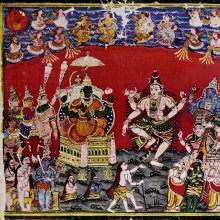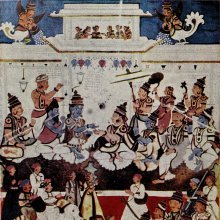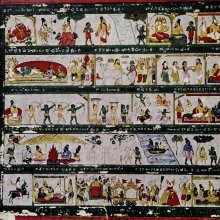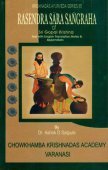Mysore: 1 definition
Introduction:
Mysore means something in the history of ancient India. If you want to know the exact meaning, history, etymology or English translation of this term then check out the descriptions on this page. Add your comment or reference to a book if you want to contribute to this summary article.
Images (photo gallery)
India history and geography
Source: Knowledge Traditions & Practices of India: Painting: A Survey (h)Mysore painting is another important legacy of classical Vijayanagara painting. The themes for most of these paintings are also Hindu deities and epic stories. With the help of a thin brush, all the jewellery and architectural features are painted over chalk paste, to give a slightly raised effect of carving, and then allowed to dry. A thin gold foil is pasted on this. The rest of the drawing is then painted using water colours..

The history of India traces the identification of countries, villages, towns and other regions of India, as well as mythology, zoology, royal dynasties, rulers, tribes, local festivities and traditions and regional languages. Ancient India enjoyed religious freedom and encourages the path of Dharma, a concept common to Buddhism, Hinduism, and Jainism.
See also (Relevant definitions)
Starts with: Mysore fig, Mysore pala indigo, Mysore raspberry, Mysore thorn, Mysore-chooth, Mysore-chuth, Mysore-gend.
Full-text (+540): Krishnarajasarvabhauma, Shritattvanidhi, Tungabhadra, Pancaratragama, Pancaratra, Kamikopabhede mrigendrottaram, Acannacarya, Mysore fig, Mysore raspberry, Mokshakarika, Mysore pala indigo, Mahisamandala, Mysore thorn, Mokshopayanishcaya, Yajurvedasaptalakshana, Vishnutrishati, Shribhashyodahritopanishadvakyavivarana, Citrashikhandyadisamhitaghatakarathapratishthadividhi, Varnabhedavidhi, Shankaranarayanashtottarashata.
Relevant text
Search found 70 books and stories containing Mysore; (plurals include: Mysores). You can also click to the full overview containing English textual excerpts. Below are direct links for the most relevant articles:
Article 371: Constitutional Implications < [January 1952]
Our Forum < [November-December 1932]
Bharata Ratna Mokshagundam Visveswaraya < [April – June, 1998]
Temples in and around Madurantakam (by B. Mekala)
Mysore Wars < [Chapter 1 - Historical Backdrop]
Maratha at Kanchipuram, 1676 < [Chapter 1 - Historical Backdrop]
Hoysalas and the Muslim Invasion < [Chapter 1 - Historical Backdrop]
Siddhanta Sangraha of Sri Sailacharya (by E. Sowmya Narayanan)
A History of Indian Philosophy Volume 5 (by Surendranath Dasgupta)
Part 6 - Vātulāgama < [Chapter XXXIV - Literature of Southern Śaivism]
Part 1 - The Literature and History of Southern Śaivism < [Chapter XXXIV - Literature of Southern Śaivism]
Part 4 - Śaiva Philosophy according to Bhoja and his commentators < [Chapter XXXVIII - Śaiva Philosophy in some of the Important texts]
Taittiriya Upanishad (by A. Mahadeva Sastri)
Vastu-shastra (5): Temple Architecture (by D. N. Shukla)
Vāvāṭa-Prāsādas (Vāvaṭa and later Chalukyan or Hoysal style) < [Chapter 12 - History of Hindu Temples (Prāsādas and Vimānas)]
Hoysaleśvara [Hoysaleswara] temple at Halebid < [Chapter 12 - History of Hindu Temples (Prāsādas and Vimānas)]
Temples in Mysore State < [Chapter 12 - History of Hindu Temples (Prāsādas and Vimānas)]
Related products
(+3 more products available)








